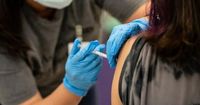As the 2025 school year begins across the United States, a troubling trend is emerging in childhood vaccination rates, with significant declines observed in both Washington and Texas. According to data from the Washington State Department of Health and the Texas Department of State Health Services, fewer kindergartners are fully compliant with state vaccination requirements than just five years ago. This decline, experts warn, could leave communities vulnerable to outbreaks of diseases once considered under control, such as measles and whooping cough.
In Washington’s Whatcom and Skagit counties, the numbers speak for themselves. Less than 82% of Whatcom County kindergartners and 86.3% of Skagit County kindergartners were fully compliant with state vaccination requirements in fall 2024, both falling below the state average of 87%. Just five years ago, those rates were 85% and 89%, respectively—a clear downward slide that mirrors national trends. The decline is not just a statistical blip; it coincides with a rise in vaccine distrust and the spread of misinformation, according to Cascadia Daily News.
Dr. Meghan Lelonek, Whatcom County’s co-health officer, didn’t mince words about the risks. “Looking at our current kindergarten vaccination rates, we see that many schools are at risk of an outbreak if an infectious disease like measles comes into their school,” she said. The numbers back up her concern: only 86% of Whatcom and 89.8% of Skagit kindergartners had the crucial measles, mumps, and rubella (MMR) vaccine in fall 2024. That’s well short of the 95% community-level goal needed for herd immunity—a threshold public health officials say is essential to prevent the spread of measles.
Herd immunity, often cited as a public health gold standard, requires that 94 out of every 100 people be immune to stop the spread of measles. When vaccination rates dip below this, the risk of outbreaks rises dramatically. Washington has already felt the impact: two measles cases in a single Whatcom County household this June cost the county $24,000 to investigate.
The situation is just as concerning in Texas, where requests for vaccine exemption forms have doubled since 2018, reaching over 93,000 in 2024, according to The Texas Tribune. In July 2025 alone, the state received 17,197 requests for exemption forms—a 36% jump over the previous July. Each request can cover up to eight individuals, meaning more than 30,000 children were covered by exemption forms that month. And starting September 1, 2025, a new Texas law will make it even easier to opt out: exemption forms will be available for download, replacing the previous requirement to receive them by mail.
Vaccination rates in Texas are following a similar downward trajectory. While the statewide kindergarten vaccination rate hovers around 93%, some districts have seen rates plummet. In the Austin Independent School District, just 79.6% of kindergartners were up to date on the MMR vaccine during the 2024-25 school year—a steep drop from 96% in 2020. In Gaines County, where a West Texas measles outbreak began in January, only 77% of kindergartners were vaccinated the same year. Texas now leads the nation in the number of kindergartners not fully vaccinated against measles, with more than 25,000 children, according to U.S. Centers for Disease Control and Prevention data released in July 2025.
Public health officials are sounding the alarm. Terri Burke, executive director of The Immunization Partnership, told The Texas Tribune, “I do think that there is a problem — period — that is worse than we have known about previously.” She also noted that vaccine skepticism has worsened, making it increasingly difficult for pediatricians and health officials to even broach the subject with parents. “Their frustration is that they can’t even bring up the subject with parents.”
In both states, the reasons for declining vaccination rates are complex. In Washington, schools are required by law to exclude students without vaccines or approved exemptions, but in practice, districts often prioritize communication and support over immediate exclusion. “Part of our back-to-school routine” is reaching out to families with incomplete immunization records, said Jacqueline Brawley, executive director of communication at Bellingham Public Schools. Students can start school with a “conditional” status if their parent or guardian is working on getting the needed vaccinations. No students have been excluded from school “in the recent past” for being out of compliance, Brawley added.
Similarly, in Texas, school nurses and administrators face mounting challenges. Funding cuts have led to fewer school nurses and health aides, increasing the workload for those who remain. The constant chase for vaccination records or exemption forms has become a year-round struggle. Some superintendents, worried about losing state funding tied to student attendance, have directed staff to let all students attend, regardless of vaccination status. Karen Schwind, a past president of the Texas Association of School Nurses, explained, “There are some superintendents that will say, ‘All kids come to school. I don't care if they've got their vaccines or not.’”
Exemptions play a significant role in the declining rates. In Washington, parents and guardians can seek four types of exemptions: medical, religious, religious membership, and personal. Medical exemptions are rare—just 14 kindergartners in Whatcom and five in Skagit had them in 2024-25. Religious exemptions are far more common, with 107 kindergartners across the two counties having them, particularly in Christian schools. Personal/philosophical exemptions number about 51 local kindergartners, though these aren’t permitted for the MMR vaccine. Even so, over 10% of kindergartners in the two counties were out of compliance in 2024-25 and lacked an exemption on file. Some of these are unhoused or foster care students, who cannot legally be excluded from school, even if not vaccinated.
In Texas, the new downloadable exemption form law has sparked debate. Vaccine supporters warn that making the process easier will further drive down vaccination rates. Rebecca Hardy, president of Texans for Vaccine Choice, counters that fears are overblown and insists her organization exists to “support all parents, regardless of how they vaccinate.” Still, the numbers are hard to ignore. In the 2024-25 school year, 2.7% of Texas kindergarteners lacked records of required measles vaccine doses and did not have exemptions.
The challenge is further compounded by external factors. In Texas, funding cuts have reduced the capacity of public health departments to provide vaccinations, especially for uninsured and Medicaid-covered children. The lingering effects of the COVID-19 pandemic, coupled with immigration policies that create a chilling effect among undocumented families, have also contributed to fewer children visiting summer vaccination clinics. “We typically have like, you know, big lines and the waiting room is packed. Our whole lobby is packed,” said Dr. Phil Huang, director of the Dallas County Health and Human Services Department. “This year it has not been that way.”
Local efforts to boost compliance are ongoing. In Washington, districts are hosting vaccination events—August 18 in Nooksack and August 23 in Bellingham—to help families get up to date. But with rising exemption rates, persistent misinformation, and stretched school health resources, the road to restoring herd immunity looks steep.
As the school year unfolds, public health officials, educators, and families alike are left to grapple with a difficult question: how to protect both individual choice and community health in an era of growing vaccine hesitancy and logistical hurdles. The stakes are high, and the solutions will require cooperation, trust, and a renewed commitment to the well-being of all children.




